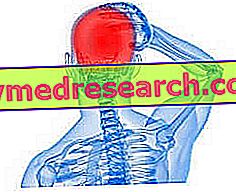Migraine phases
During a typical migraine attack, several distinct phases are recognized, although the patient may not necessarily cross all of them:

- Prodromal phase : occurs hours or days before the headache occurs;
- Aura : immediately precedes the migraine;
- Phase of pain : corresponds to the acute headache phase;
- Resolution (or recovery) phase : includes the symptoms and disorders experienced after the end of a migraine attack.
Prodromal phase
Prodromal symptoms occur in about 60% of migraine sufferers; typically, these symptoms make their onset several hours or days before the onset of pain or aura.
The prodromal phase can include a wide range of phenomena including: mood alterations, irritability, depression or euphoria, fatigue, cravings for certain foods, muscle stiffness (especially in the neck), constipation or diarrhea and sensitivity to odors or noises. The prodromal phase can occur in migraine with or without aura.
Aura
Some people experience transient neurological phenomena of a visual, motor or sensory nature (aura), which appear gradually just before the painful phase begins and can continue even during the migraine attack. This phase can normally last from 15 minutes to an hour. Only rarely can the aura appear without a headache following it; this condition is known as silent migraine.
Phase of pain (migraine proper)
Migraine usually presents with unilateral, intense and throbbing pain. In some cases, however, headaches can be bilateral (particularly common in migraine sufferers without aura) and can be associated with neck pain. Less commonly, pain can occur especially in the back or upper part of the head. Pain usually lasts 4 to 72 hours in adults, while in children it often lasts less than an hour.
At least one of the following conditions is generally associated with the onset of pain: nausea or vomiting, tiredness, irritability, extreme sensitivity to light, odors and sounds. Generally at this stage, a number of other symptoms also appear, including: blurred vision, stuffy nose, diarrhea, frequent urination, pallor, sweating, neck stiffness, etc.
The frequency of attacks is variable: some subjects often suffer from migraine, which afflicts them several times a week, while other people experience only one migraine episode from time to time.
Resolution and recovery phase
Most attacks gradually fade spontaneously. Rest often helps to alleviate symptoms. However, the effects of migraine may persist for a few days after the migraine attack has been resolved. At this stage cognitive difficulties, gastrointestinal symptoms, mood changes, feelings of exhaustion and weakness may occur. In particular, some people feel unusually euphoric after an attack, while others show a condition of depression and general malaise.
Causes
The causes at the origin of the migraine have not yet been precisely defined. It is believed that the aetiology can be connected to the intervention of various environmental, biological and genetic factors . Furthermore, some psychological conditions are typically associated with migraine, including depression and anxiety .
Over time, various hypotheses have been formulated.
- The main theory is related to the alteration of the pain regulation system, connected to a greater excitability of the cerebral cortex (most external part of the brain) and to the malfunctioning of an area of the brain stem responsible for the control of painful stimuli. The effect of this mechanism involves the consequent involvement of the trigeminal nerve fibers (one of the main nerve pathways involved in the propagation of pain in the skull).
- The fluctuation of hormone levels can play an important role: some women report suffering from migraine from two days before to three days after the appearance of menstrual flow, a period that corresponds to a decrease in the level of estrogen. The imbalance of some chemical messengers, such as endorphins and serotonin, which act as natural analgesics, could also be a cause of migraine. In fact, these neurotransmitters contribute to counteracting painful stimuli, performing an action on the antinociceptive system. During migraine, hormonal fluctuations and / or neurochemical stimuli can lead to an exaggerated stimulation of the sensory nerves (in particular, of the trigeminal nerve fibers) that surround the blood vessels of the head and neck; this would induce the narrowing of the blood vessel size, with a consequent reduction in blood supply to particular brain areas. The physiological effect thus determined can justify the onset of aura symptoms. Subsequent dilation of blood vessels can cause the actual feeling of pain in the head. The mechanism by which neurotransmitters and hormones participate in the onset of migraine is still not entirely clear.
- According to another hypothesis, migraine could be the result of a hereditary constitutional predisposition to react to external and internal stimuli. As a consequence, the brain triggers the migraine attack in genetically predisposed subjects . In particular, migraines would seem to respect a tendency to be transmitted within the same family (in about two thirds of the cases) and would be connected to the presence of a certain number of specific gene variants, which increase the risk of the disorder occurring .
Triggering factors
Many factors have been identified as triggers for migraine attacks. These stimuli include emotional, physical, food, environmental and medicinal factors.
| Emotional stimuli |
|
Physical and physiological stimuli |
Migraines generally do not occur during the second and third trimesters of pregnancy or after menopause. |
Food / dietary stimuli |
|
Environmental causes |
|
drugs |
In some patients, taking hormonal drugs (contraceptive pill and hormone replacement therapy) tends to worsen the migraine, while other women report a positive effect. |



